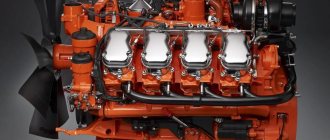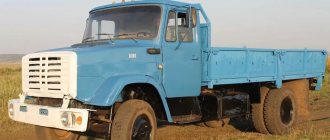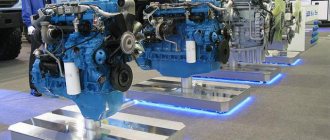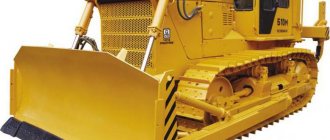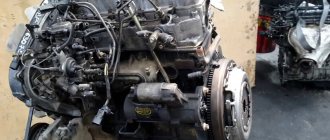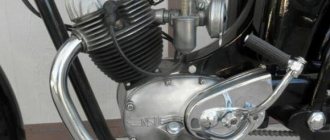- home
- Media center
- Articles
- Engine ZIL 645
Menu
- News
- Articles
- Video materials
- Photo materials
- Publication in the media
- 3D tour
14.07.2020
The 4331 series truck became widespread and over time began to be mass produced. Its main feature was the ZIL 645 engine, the advantages of which are improved reliability, service life and performance compared to previous models of identical versions of the car. This motor is easy to maintain and does not cause headaches for the owner.
History of creation
The ZIL 645 engine was designed specifically for the ZIL 4331 series truck, which was produced at a Moscow automobile manufacturing plant in the seventies of the last century. At that time, the USSR automobile industry was in dire need of engines with high performance. This prompted the developers to create such an engine.
The engine is made on the basis of the motor that was equipped with KAMAZ models, so it is not completely new. The unit was produced in two versions, one of them ran on gasoline, the other on diesel. The cost of diesel fuel has fallen, so it has become more profitable to operate trucks with a similar engine. This explains the number of trucks created by the manufacturer with ZIL 645 diesel engines, which exceeds one and a half million copies.
Initially, the developers planned to create a multi-fuel engine. Therefore, the engine acquired an original mixture formation system in the form of a volumetric film version. This factor made it possible to install fuel equipment and implement a gasoline model.
Due to the presence of such an engine in the design of the onboard ZIL 4331, the car easily bypassed even KamAZ trucks on the highway. This is why the owners fell in love with the engine. But at that time there were also significant disadvantages, which consisted in the difficulties of finding and purchasing spare parts.
ZIL-136: outdated, approaching the conveyor
In 1968, ten years after the start of work, MosavtoZIL stopped all work on the ZIL-136 diesel engine.
Work on diesel engines was started in pursuance of the resolution of the Central Committee of the CPSU and the Council of Ministers of the USSR dated April 17, 1958 No. 442.
Diesel, the design of which was developed in 1959 by the Moscow Automobile Plant named after. Likhachev with the help of NAMI, was originally intended for installation only on export modifications of ZIL trucks. For the ZIL-136 diesel engine, a vortex chamber working process was used, for which there was extensive experience. In 1960, NAMI created a single-cylinder unit for testing the working process of the ZIL-136.
65.7% of the ZIL-136 diesel parts were completely unified with the ZIL-130 engine. To increase the degree of mutual unification of the ZIL-136 diesel engine with the ZIL-130 carburetor engine, the design of the latter was incorporated into the design of the latter in 1959–1960. made a number of changes. When developing an automatic line for machining the cylinder block of the ZIL-130 engine, additional positions and machines were provided for processing specific diesel elements of the ZIL-136 cylinder block.
From 1959 to 1965 The plant produced 12 diesel engines in four batches, consistently improving the design, eliminating major defects in the main engine parts and increasing the reliability of the diesel engine as a whole. The effectiveness of the changes was tested in bench and road conditions. To eliminate burnout of the head gasket, the diameter of the studs was increased from 14 to 16 mm, which made it possible to increase the tightening torque. To increase the rigidity of the power belt of the block, the windows in the partitions connecting the main bearing supports with the block crankcase were eliminated, and additional ribbing was introduced for the load-bearing part of the crankcase block. Since the main bearing caps of the ZIL-130 engine showed insufficient strength, their design was strengthened, the bolt material was replaced and the screw-in depth was increased. For the crankshafts of the 4th series diesel engines, the size of the connecting rod journal dumbbells was increased, since the fatigue strength of the ZIL-130 crankshafts turned out to be insufficient. To prevent breakage of the inter-piston bridges, they were enlarged, and the piston bosses were also strengthened. In addition, the piston material was changed. The diameter of the piston pin was increased from 32 to 34 mm, also changing its material. The material of the exhaust valves has been changed. Malleable cast iron rocker arms were replaced with stamped steel ones.
By the end of 1965, diesel samples passed laboratory and road tests, including 1,200 hours of reliability testing, 300 hours of operation at maximum power and mileage on vehicles with the greatest length of up to 48 thousand km. According to the conclusion of the commission created in 1966 by the Ministry of Automotive Industry, the design of the ZIL-136 diesel engine has been brought to a state that allows it to begin its preliminary small-scale production in order to accumulate relevant operational experience and finalize the design and technology for manufacturing parts of the ZIL-136 diesel engine before deploying its production line production.
ZIL-136 developed power of 122–125 hp. at 2800 rpm and was suitable for single vehicles of the ZIL-130 family with a gross weight of 10 tons in various road conditions and on a road train with a gross weight of 16 tons when operating on roads with improved surfaces. In 1966 and 1967 Five more experimental engines were produced.
Meanwhile, the need for the ZIL-136 diesel engine has increased due to problems with the export of ZIL trucks. There was also a need for dieselization of ZIL trucks supplied within the country. However, preparations for small-scale diesel production did not begin. The ideas basically boiled down to the following.
- The idea of creating a diesel engine based on a carburetor engine is fundamentally flawed and has long been compromised.
- The ZIL-136 diesel engine has an outdated type of working process; there is a more economical mixture formation with direct fuel injection.
- For ZIL class cars abroad, in-line 6-cylinder diesel engines are predominantly used.
- The ZIL-136 diesel engine has a power of only 125 hp. This power is not enough for ZIL-131 vehicles, ZIL road trains with a total weight of 16 tons when operating on roads without hard surfaces, and even more so this power is not enough for promising trucks.
- Domestic equipment cannot provide mechanical processing of ZIL-136 parts with the precision that is required for a diesel engine.
- The design of the ZIL-136 diesel engine is already outdated and cannot provide this diesel engine with competitiveness in the international market.
When deciding on putting the ZIL-136 diesel engine into production, according to the chief designer of ZIL A.M. Krieger, the question of its prospects for the next ten years (of which one year is needed to complete its testing and development, two years to put it into mass production and at least seven years for serial production) should be additionally considered, both from the point of view of the possibility of subsequent increasing power data (without loss of service life), and from the point of view of the vortex chamber process underlying its design (replaced by direct injection on almost all modern diesel engines of trucks).
In 1967, NAMI developed the NAMI-0116 engine - a prototype version of the ZIL-136 diesel engine with cylinder diameters increased to 110 mm (instead of 100 mm), a displacement of 7.25 liters, and a power of 140 hp. Work on the engine was stopped in 1968 due to the cessation of work on the ZIL-136 diesel engine.
The Scaldia-Volga SA company offered trucks of the ZIL-136 IDI type with a 6-cylinder Perkins Diesel M 6354 engine. The diesel engine had a displacement of 5.8 liters and developed a power of 130 hp. at 2800 rpm. The company also purchased and installed Leyland 0.400 (Great Britain) and Valmet 411BS (Finland) diesel engines on ZIL-130 trucks.
Main characteristics
The product is a V-shaped four-stroke in-line engine ZIL 645 with eight cylinders, designed for a volume of 8.74 liters. There are two valves for each cylinder. The engine produces a power rating of 185 horsepower with maximum torque, which is equivalent to 510 Newton meters. On average, it consumes up to 24 liters of fuel when traveling 100 kilometers.
Other unit parameters:
- compression – 18.5;
- cylinder diameter – 110 mm;
- piston stroke – 115 mm;
- weight – 650 kg;
- compression ratio 17.0;
- cooling type – liquid system.
Recommended lubricant is 10W-40 and 15W-40.
Design features of the motor
The production of the ZIL 645 engine was carried out on the basis of high-quality cast iron, so the engine turned out to be heavy, but at the same time durable and resistant to the spread of corrosion. There are wet cylinders, which the manufacturer has sealed at the top to prevent displacement along the axis. The lower part of the device is clamped with rubber hoops. The voids in which the liquid moves are divided by sections that form closed cavities to increase rigidity.
The camshaft is made of steel and its operation is carried out using two gears. The mechanism is fixed by several supports; the pastel is equipped with metal bushings at the fixation points.
The ZIL 645 engine has good technical characteristics, which allows it to still maintain its competitiveness. The internal combustion engine is equipped with a carburetor and 2 chambers with a falling flow. Inside the device there is a pumping element and an economizer. In addition, there is a mechanism that turns on the idle speed.
The ZIL 645 engine block is equipped with liners that are sealed with rings at the bottom of the block. The heads are made of high-strength aluminum (the composition also contains other metals). The displacers are also made of aluminum and are surrounded by rings: on top there are two compression metal rings coated with chrome, and another one is required to remove the lubricant.
The ZIL 645 engine does not overheat due to the liquid, which continuously moves in a closed loop in a circle through channels inside the engine. To reduce the impact of friction forces, add oil. The lubrication system operates using a combined method - the liquid moves through the pipes and is sprayed by gravity. The unit is powered by the forced supply of fuel, which is organized by the pump.
Thanks to the V-shaped arrangement of the cylinders, the engine gained high performance and torque. The piston group and cylinders are started by a single crankshaft.
At the bottom, the engine crankcase is covered with a tray made of sheet steel. The pan protects the crankcase from the penetration of contaminants and is used as a reservoir for lubricant. During engine operation, gases enter the crankcase, which can lead to an increase in pressure. For this reason, the crankcase communicates with the atmosphere through a tube.
To access the ZIL 645 engine, engineers used a solution that was innovative at that time. All front parts, which are a single unit, use hinges. They make it possible to tilt the structure forward. This is convenient in terms of repair and maintenance, since mechanics have full access to the unit and all other components that are located in the engine compartment.
Exterior
The external design of the car is shaped like a rectangle. In the front part there is a high-placed original radiator grille. On the sides there are mudguards sharply separated from the entire body. The wheels are set deep, and the bumper, made of durable metal, protrudes forward.
The design of this element covered most of the cabin, serving as protection against accidental damage. The workplace itself has an angular configuration. The 645-ZIL truck received a tipper section, allowing it to transport various bulk cargoes. It was also possible to transport concrete, wood, and metal structures.
Engine Maintenance
Valves should be adjusted as needed, but clearances should be checked every 500 hours of operation. The valve clearances must correspond to the following indicators: inlet 0.25 mm, exhaust 0.45 mm.
The lubricant needs to be changed every 10-15 thousand km of the distance traveled. The oil becomes contaminated with small particles that gradually penetrate into the system.
Every 20 thousand kilometers you should undergo scheduled maintenance. Maintenance includes checking the spark plugs, draining the sludge from the oil filter, replacing the latter and fuel and air filters, cleaning dust and dirt from the ignition system devices and other work.
Every day it is recommended to clean the engine of dirt, carefully inspect it, listen to its operation in different modes, check the fluid level in the radiator, the lubricant level before starting and check for lubricant leaks.
Main types of breakdowns and malfunctions
According to statistics, when regular maintenance is performed in accordance with the manufacturer’s recommendations, the unit operates stably and does not break down often. But at the same time, as is the case with other types of equipment, the ZIL 645 engine has a number of standard malfunctions that are encountered most often.
- Piston group repair
The pistons and cylinders of the ZIL 645 power engine wear out over time and fail. With regular repair work, it becomes possible to replace the liner of one of the engine cylinders, provided that the others do not show signs of significant wear.
When troubleshooting a problem like this, you need to consider the following points:
- sleeves to be replaced should be divided by size;
- The lower connecting rod and bearing caps are replaced with suitable sets.
new pistons must have the same dimensions as the worn ones;
This problem occurs quite often in ZIL 645 diesel engines. Some mechanics tried to deal with it by changing the fuel supply, but they still could not completely eliminate it. The solution is to periodically replace the valve and spring system to extend the service life of the entire assembly.
It fails due to poor fit of the valves to the sockets and their incomplete opening. If the valves do not fit properly, compression decreases, popping sounds appear in the intake manifold, and engine performance decreases. The problem is caused by carbon deposits on the seats, faulty valve springs, or the formation of cavities on the working surfaces.
The problem arises due to the use of low-quality fuel, incorrect setting of the injection timing, and defective injectors. In the winter season, the ZIL 645 engine has difficulty starting, since it is warmed up using a standard heater, which is not reliable.
With a strong increase in temperature, the pistons experience increased load, which leads to their rapid wear, carbon formation and other problems.
At lower temperatures, fuel consumption increases, resin penetrates into the ventilation system, and additional load is placed on the pistons. Unstable operation of the cooling system is caused by a lack of cooling fluid, a broken fan belt and improper functioning of the thermostat.
Advantages and disadvantages
The ZIL 645 engine has the following advantages:
- Stable operation at low speeds;
- Lack of increased fuel requirements (owners often use the 92 rather than 95 marking);
- Long service life - about 200 thousand km with no need for major repairs;
- Simplicity of design and ease of repair and installation;
- Ability to work in harsh climatic conditions;
- High degree of reliability.
The disadvantages of the ZIL 645 engine include the lack of special degree grids for adjusting the motor according to the engine advance angle and sometimes difficulties in finding spare parts for replacement.
Where is the Frame Number Zil 130 ~ VESKO-TRANS.RU
Frame number zil 130 photoYou are interested in: Frame number zil 130 photo . (Photos on this topic are collected here, but relevance is not guaranteed.) If you find that any photo violates copyright or is of an inappropriate nature, please let us know ().Warelius: chassis number ram zil-130 sourceRama zil 131 - Spare parts. Rubtsovsk source Engine and chassis numbers on the ZIL-157 - Forum source forum Truckers Trucking u2022 View topic - ZIL, where is the number. sourceChoice of ZIL 43. | Forum ZIL 131/ sourcePlate on the cabin. | Forum ZIL 131/ sourceNo flood] Help out! Photo of frame numbers sourceforum Truckers Trucking u2022 View topic - ZIL, where is the number . source Engine and chassis numbers for ZIL-157 - Forum source Frame of ZIL-133G40 and ZIL-133D42 cars | Auto parts for ZIL. source
Zil 1995
VK group.
Review of ZIL - 130
auto truck 4 years old license plate
the rear one was completely rusty ((was located behind the rear wheels) the front partly...Forum of owners and lovers of ZIL 157 u2022 View topic - number on. sourceSsangYong Rexton: Down with prejudice sourceFrame, towing device | Auto parts for ZIL 131 | Auto catalog sourceZIL 130 frames, Donetsk sourceCar frames ZIL-431410, ZIL-431510, ZIL-495810 and ZIL-431917. sourceFrame | Auto parts for ZIL 433360 | Auto catalog spare parts ZIL sourceFrame ZIL 431410 (130) (Drawing No. 27: list of parts, cost. source We install the manipulator on Dyna, questions about reinforcement frames. sourceZIL frame number 130 photo | Photos of cars sourceFrame of the car ZIL-5301 ZIL-5301 (2006) (Drawing No. 95: list.sourceFrame | Auto parts for ZIL 433100 | Autocatalog of spare parts ZIL sourceFrame, towing device ZIL 131u2014 sourceFrame ZIL-433110 (Drawing No. 73: list of parts, cost of spare parts. sourceZIL 130(554) collective farmer-disassembly. :: JARMAROK - catless sourceZIL 130(554) collective farmer-disassembly. :: JARMAROK - catless. source Frame ZIL 433360u2014 source Frame ZIL 130, Donetsk sourceGolden hands! u2014 Dirty models source Frame of truck tractors ZIL-131NV and ZIL-137T | Auto parts for ZIL. source
